If you’re planning a trip to Paris and you love art (or even if you just think you love art), the Musée d’Orsay should be on your radar. Trust me, you’re going to want to carve out a few hours for this place. First off, it’s in a former train station, so the building alone is worth the visit – just try not to be distracted by the grand clock when you first walk in, or you’ll feel like you’re in an art heist movie.
But what really makes the Orsay special is the collection. If you’re a fan of Impressionists and Post-Impressionists – hello Monet, Van Gogh, Degas, and Renoir – you’re in for a treat. The paintings practically breathe history, and the way they’re displayed makes you feel like you’re stepping into the artists’ minds (without any of the existential dread). It’s like a time machine, but with way better art than a typical museum visit.
The museum does an incredible job showing the evolution of art during one of the most exciting periods in history – when the world was changing rapidly and artists were trying to keep up. From the grounded realism to the revolutionary modernism, the Orsay has it all. And the best part? They rotate temporary exhibitions, so even if you’ve been before, you can always catch something new (like an art lover’s version of a Netflix binge).
Basic Informaiton
Opening hours
- Tuesday to Sunday: 9:30 AM – 6:00 PM
- Thursday (late opening): 9:30 AM – 9:45 PM
- Closed: Monday, January 1st, May 1st, and December 25th
Ticket Information
- Standard Tickets: €16
- Reduced Price: €13
- Visitors between 18 and 25 years old who are not EU residents.
- Disabled visitors and one companion.
- Teachers and students of art schools.
- Job seekers and those receiving certain welfare benefits.
- Free Admission:
- For all visitors under 18 years old, regardless of nationality.
- EU residents under 26.
- Members of the museum’s professional partner networks and press.
- Anyone on the first Sunday of each month (note that this can be busy, so be prepared for crowds).
- Special Tickets:
- Combo Ticket (Orsay + Orangerie): €22. This ticket allows you to visit both the Musée d’Orsay and the Musée de l’Orangerie (which houses Monet’s Water Lilies) within the same 4 days
- Museum Pass: If you’re planning to visit multiple museums and monuments in Paris, the Paris Museum Pass gives you access to the Orsay (along with many other museums) for a set number of days, which can save you money and time.
How to Get to Musée d’Orsay


The Musée d’Orsay is located in the heart of Paris, along the left bank of the Seine River. Its address is: 1 Rue de la Légion d’Honneur, 75007 Paris, France. It’s situated in the 7th arrondissement, close to iconic landmarks like the Tuileries Gardens and Place de la Concorde.
Getting There By Metro:
- Line 12 (Green Line): Get off at Solférino station, which is about a 5-minute walk from the museum.
- Line 1 (Yellow Line): Get off at Tuileries station, which is a bit further but still just a 10-minute walk along the riverbank to the museum.
- Line 7 (Pink Line): Get off at Assemblée Nationale station, about a 10-minute walk from the museum.
Getting There By RER (Regional Express Train):
- RER C: This line is particularly handy. Take it to the Musée d’Orsay station, which is right next to the museum! It’s an easy access point if you’re coming from locations like Gare d’Austerlitz or Notre-Dame.
Getting There By Bus:
- Bus 24, 63, 68, 69, 73, 83, and 94 all have stops near the Musée d’Orsay.
- The bus stop you’ll want is called Solférino – Musée d’Orsay (for buses 63 and 24), located just a short walk from the museum entrance.
Getting There By Foot:
- Louvre Museum: Around a 15-minute walk along the river.
- Place de la Concorde: About 10 minutes on foot.
- Jardin des Tuileries: Only about 10 minutes by foot.
Getting There By Boat (Batobus):
- For a unique and scenic route, you can also take the Batobus, which is a boat shuttle service along the Seine. The Musée d’Orsay is one of its stops, so you can enjoy views of the river while heading to the museum.
Various Guided Experiences at Musée d’Orsay
1. Audio Guides
- Languages: The museum provides audio guides in multiple languages, including English, French, Spanish, German, Italian, Japanese, Chinese, and more.
- Cost: €6 (additional charge).
- How to Get One: Audio guides can be rented at the museum’s entrance or booked online in advance.
2. Guided Tours
- In-Person Tours: These are typically led by knowledgeable museum guides who can provide deeper insights into the museum’s collections.
- Cost: Prices for these tours vary, usually starting at around €50 to €80 per person, depending on the tour type and duration.
- Duration: Most tours last around 2 hours and are available in several languages, including French and English.
3. Mobile App
- Musée d’Orsay App: The museum has its own free mobile app available for download. It includes a range of tools for self-guided tours, detailed descriptions of key artworks, and information on exhibitions and events.
- Languages: Available in French and English.
- Features: The app also provides a map of the museum, allowing you to navigate through the galleries and learn more about specific pieces.
Top Things to See and Do at Musée d’Orsay
Floor Plan of Musée d’Orsay
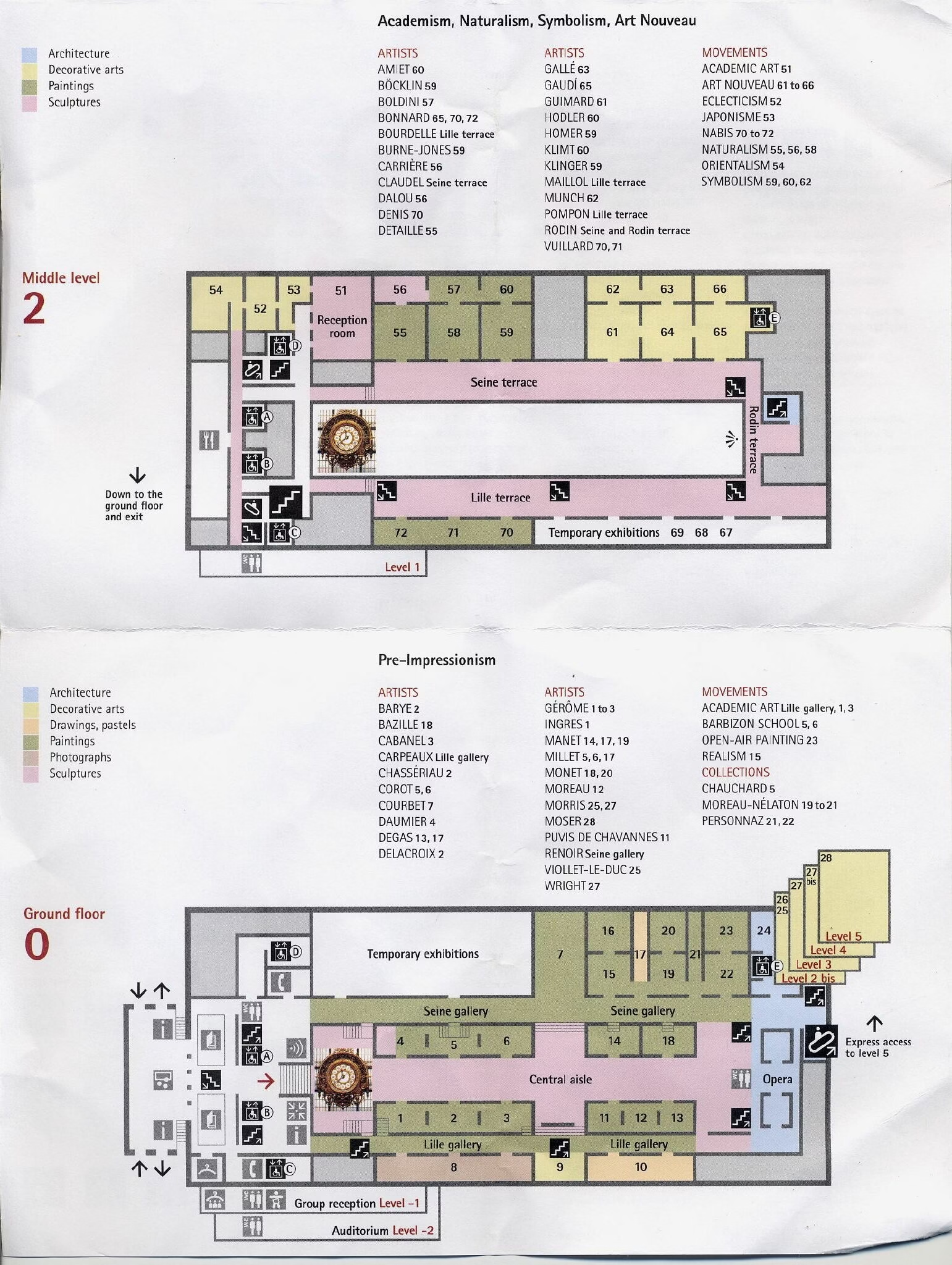

The Architecture of the Museum
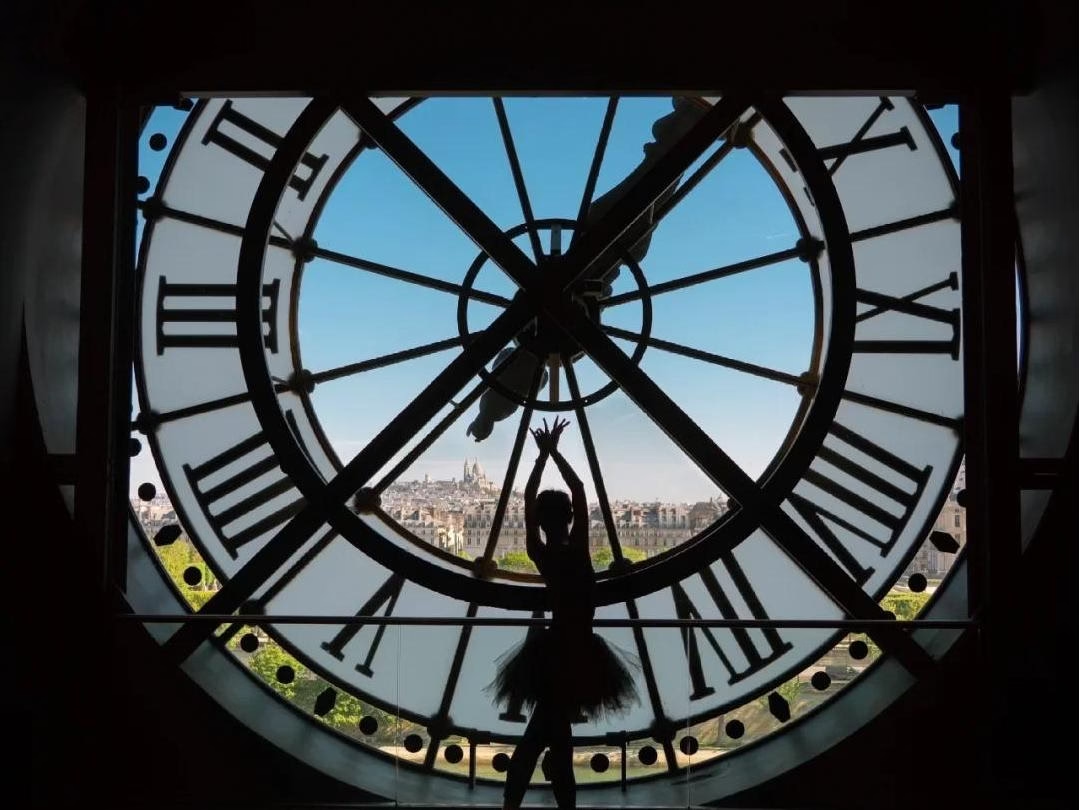
Before immersing yourself in the world-class art collection, it’s essential to admire the museum’s architectural marvel. Originally designed by Victor Laloux as the Orsay Railway Station, which opened in 1900 for the Exposition Universelle (World’s Fair), the station’s massive Beaux-Arts structure was transformed into a museum in 1986. The structure’s vast glass-and-steel roof spans an impressive 132 meters (433 feet), filling the space with natural light. At the heart of the building is the iconic 19th-century clock, suspended above the central nave, offering visitors a unique view of Paris through its intricate glasswork. The towering arches and grand steel trusses, coupled with the open space below, create an almost cathedral-like atmosphere. To fully appreciate the grandeur, head to the top floor, where you can not only marvel at the architecture but also get a panoramic view of the galleries beneath.
Impressionist Masterpieces
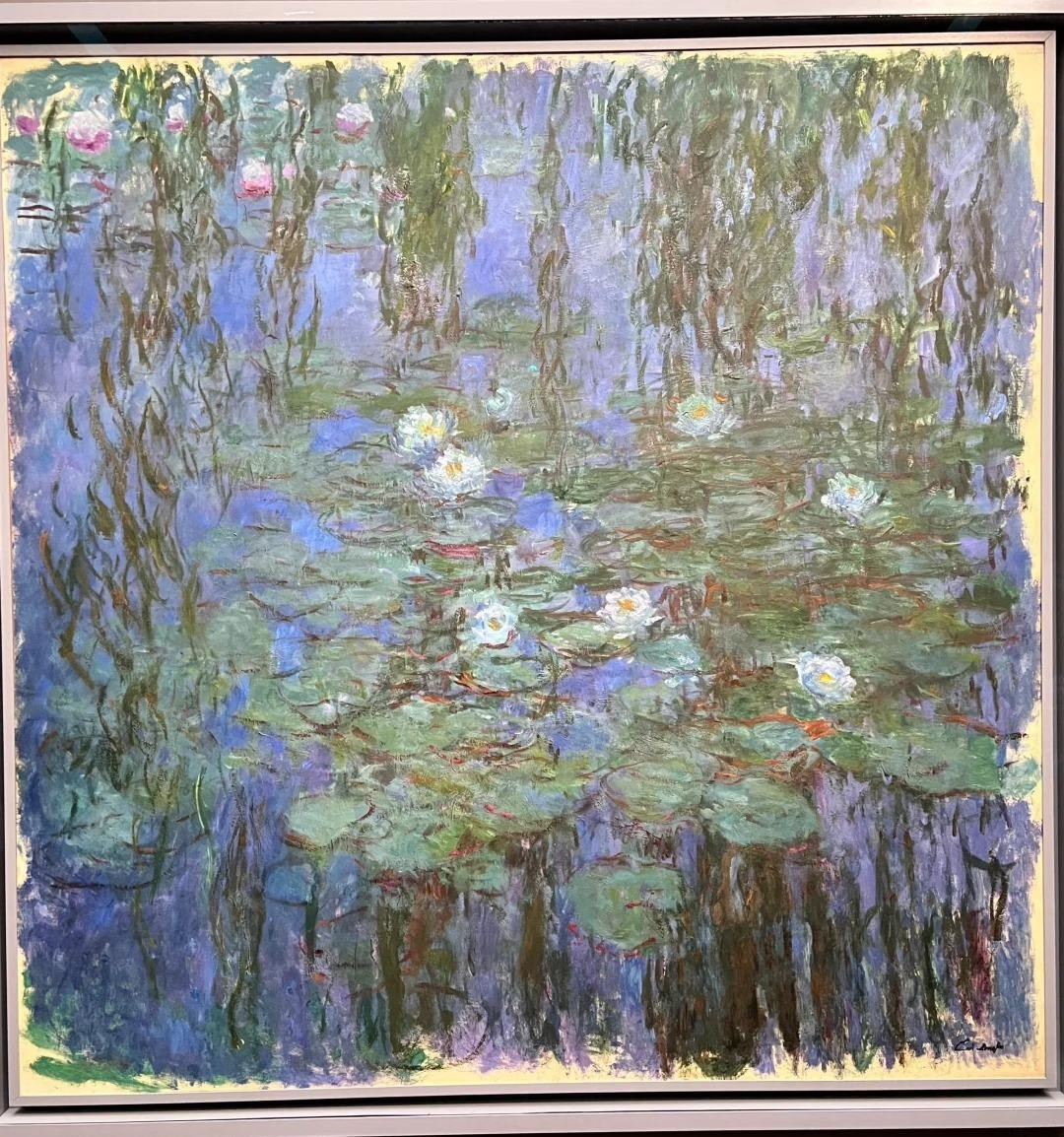
The Musée d’Orsay is home to the world’s finest collection of Impressionist art, a movement that revolutionized the way we see the world and art. Some of the museum’s most iconic pieces include:
- Claude Monet’s Water Lilies and Woman with a Parasol
- Édouard Manet’s Olympia and Luncheon on the Grass
- Pierre-Auguste Renoir’s Dance at Le Moulin de la Galette
- Edgar Degas’s Ballet Rehearsal and The Ballet Class
Monet’s Water Lilies in particular, with its soft color transitions and atmospheric quality, exemplifies the Impressionist obsession with capturing the fleeting effects of light. Renoir’s Dance at Le Moulin de la Galette not only shows the joy and bustle of outdoor Parisian life but also how Renoir’s use of light and shadow gives an impression of movement, a core feature of the Impressionist style.
Post-Impressionism and Symbolism
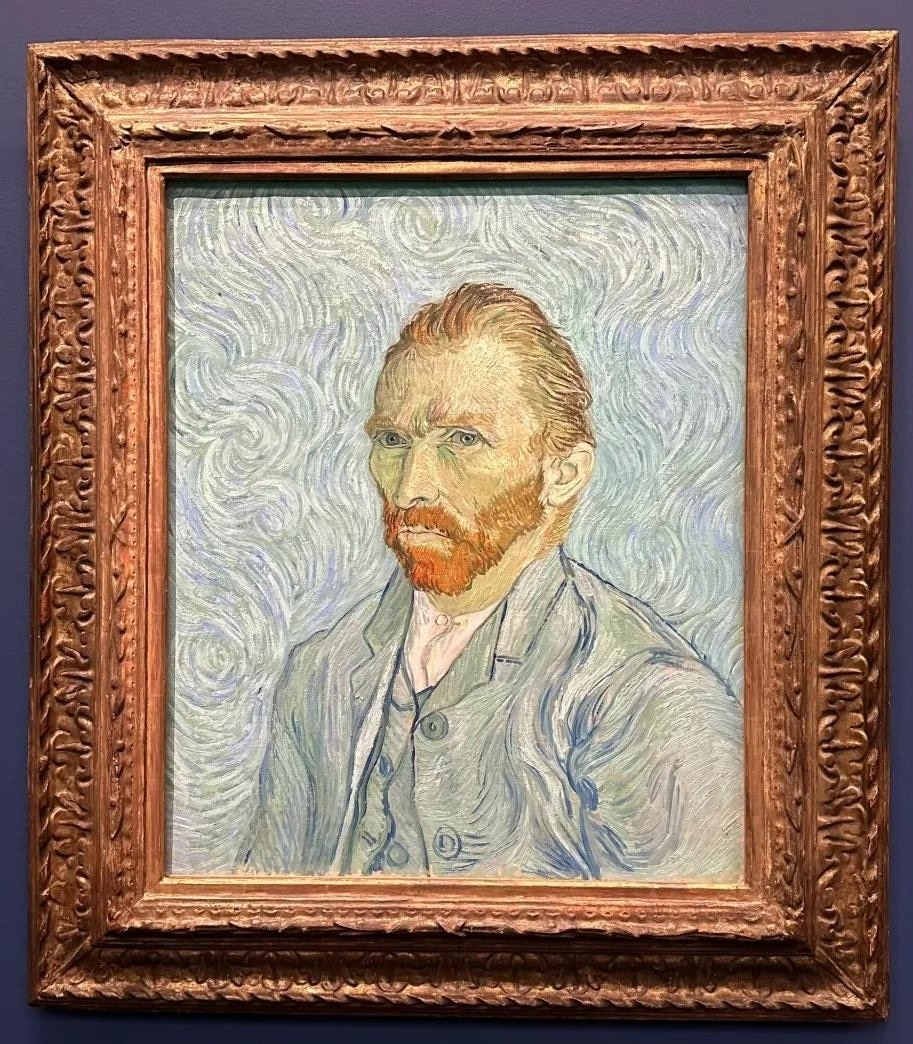
The Musée d’Orsay also boasts significant collections of Post-Impressionism and Symbolism, marking the transition to modern art. Key works include:
- Vincent van Gogh’s Self-Portrait and Starry Night over the Rhone
- Paul Cézanne’s Mont Sainte-Victoire
- Gauguin’s The Yellow Christ and Vision After the Sermon
- Toulouse-Lautrec’s At the Moulin Rouge
Van Gogh’s Self-Portrait stands out as a dramatic, introspective study of the artist’s troubled inner life, while his iconic Starry Night captures the swirling, otherworldly movement of the sky. Paul Cézanne’s Mont Sainte-Victoire is a brilliant exploration of geometric form and perspective. As you journey through this section of the museum, you’ll see how these artists pushed the boundaries of representation and emotion.
The Sculptures and the Grande Galerie

The museum is home to an impressive collection of sculptures housed in its Grande Galerie. Among the highlights is the work of Auguste Rodin, whose sculptures such as The Thinker and The Gates of Hell have become symbols of the emotional power of modern sculpture. Camille Claudel, Rodin’s muse and lover, is also well represented with several works that express intense emotion and psychological depth. Her piece, The Waltz, is particularly notable for its sensuous portrayal of movement.
In addition to Rodin, the Grande Galerie features works by other great sculptors of the 19th century, such as Jean-Baptiste Carpeaux and François Rude. Don’t miss Carpeaux’s Ugolino and His Sons, a deeply emotional work that exemplifies the dramatic intensity of 19th-century sculpture.
Art Nouveau and Decorative Arts
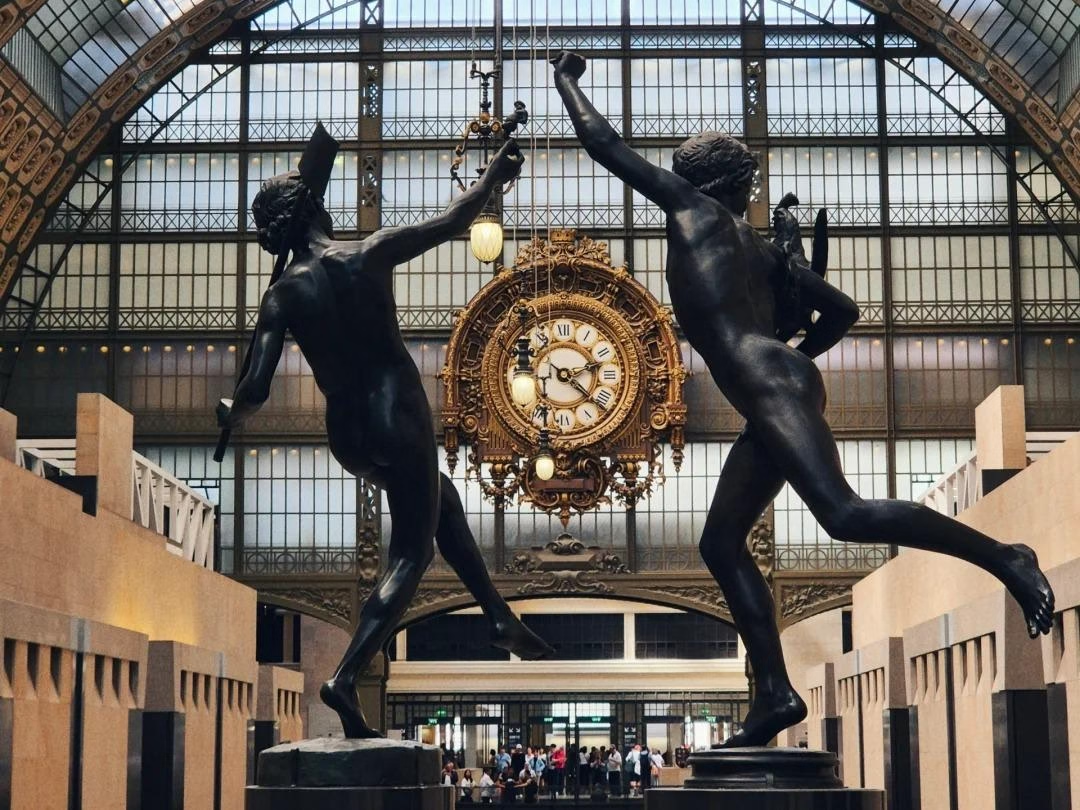
The Musée d’Orsay also offers a breathtaking array of Art Nouveau objects, known for their organic forms and integration of nature-inspired motifs into design. The collection features masterpieces like:
- Hector Guimard’s Métro Entrances (1900), with their signature sinuous, plant-like wrought-iron designs that have become synonymous with Parisian public transportation.
- Émile Gallé’s glass vases, which incorporate flowing organic patterns inspired by nature, showcasing the Art Nouveau obsession with integrating natural forms into art and design.
- Louis Majorelle’s furniture, which blends wood and floral inlays to create elegant, intricate works of art.
These pieces, along with ceramics and jewelry, demonstrate the decorative art movement’s desire to elevate everyday objects into works of art, harmonizing beauty with function.
The Collection of Photography

The Musée d’Orsay has increasingly focused on photography, with a growing collection from the late 19th and early 20th centuries. Among the highlights is the work of Nadar, one of the most famous photographers of the 19th century, known for his portraits of celebrities, writers, and artists, including Gustave Courbet and Sarah Bernhardt.
Additionally, Édouard Baldus and Charles Marville captured Parisian architecture, providing insight into the transformation of the city during the industrial revolution. If you’re interested in the development of photography as an art form, this section of the museum offers a fascinating perspective.
The Impressionist and Modern Art Rooms

The Impressionist and Modern Art Rooms take you on a chronological journey through the development of the 19th and early 20th centuries. Here, you’ll see the evolution of art from Realism to Impressionism, and onward into the Modernist and Fauvist movements. The collection spans the rise of photography, the innovations of Cubism, and the birth of Abstract Art. Artists such as Henri Matisse, Georges Braque, and Amedeo Modigliani provide context to how art evolved from representational to experimental. One standout is Henri Rousseau’s The Dream, which encapsulates his naive, dream-like style with its exotic jungle scene.
Best Time to Visit Musée d’Orsay
Best Time of Year: The best time to visit is during the off-peak seasons, which are typically from October to March. During these months, you’ll find fewer tourists, so you’ll have a better chance of really soaking in the art and enjoying the museum at your own pace. Paris can get pretty chilly in the winter, but the museum is warm and welcoming.
The summer months (June to September) tend to be busier in Paris, with more tourists in general. If you’re visiting then, try to arrive early in the morning or later in the evening to dodge the crowds. But honestly, anytime is a good time to visit as long as you’re prepared for more people during peak seasons.
Best Time of Day: For the best experience, aim for a morning visit, ideally right when the museum opens at 9:30 AM. This is when the museum is least crowded, so you’ll have a peaceful start to your visit, and you can enjoy the artwork without bumping into too many people. Alternatively, visiting in the late afternoon (after 4:00 PM) can also be quieter, as the crowds start to thin out before closing time at 6:00 PM.
Top 5 Dining Options Within and Near Musée d’Orsay

1. Le Musée
- Distance from Museum: Located inside the museum.
- Average Cost per Person: €25-40.
- Signature Dishes: French classics such as duck confit, coq au vin, and crepes Suzette.
- Features: This elegant café inside the museum offers a refined atmosphere with large windows and views of the Seine. It’s perfect for a more relaxed lunch or coffee break after visiting the galleries. The décor is a nod to the museum’s history as a former railway station, adding a special ambiance to your meal.
2. Le Comptoir du Relais
- Distance from Museum: 10-minute walk (1 km).
- Average Cost per Person: €40-60.
- Signature Dishes: Foie gras, rôtisserie chicken, and classic French onion soup.
- Features: This Parisian bistro offers a true taste of local life with a bustling atmosphere and traditional French cuisine. The rôtisserie (roast meats) here is especially popular, offering a comforting and rich meal.
3. Café de Flore
- Distance from Museum: 8-minute walk (800 meters).
- Average Cost per Person: €30-50.
- Signature Dishes: Croque monsieur, escargots de Bourgogne, and pastries.
- Features: One of the oldest and most iconic cafés in Paris, Café de Flore is a must-visit for those wanting to experience a true Parisian café culture. It’s a bit of a walk from the museum but worth it for the timeless charm, delicious food, and people-watching opportunities.
4. Les Deux Magots
- Distance from Museum: 8-minute walk (800 meters).
- Average Cost per Person: €30-50.
- Signature Dishes: Steak frites, salmon tartare, and French pastries.
- Features: Another iconic Parisian café, Les Deux Magots has long been a meeting place for writers, artists, and philosophers. Situated in the Saint-Germain-des-Prés district, it’s the ideal spot for a relaxed meal or drink.
5. Le Relais de l’Entrecôte
- Distance from Museum: 6-minute walk (600 meters).
- Average Cost per Person: €30-45.
- Signature Dishes: The restaurant is famous for its steak frites, with a secret sauce that keeps people coming back.
- Features: For meat lovers, Le Relais de l’Entrecôte is a must-try. Known for its no-frills menu focused on steak, the restaurant offers a simple yet incredibly satisfying dining experience. There’s just one main dish- steak with unlimited fries- done perfectly every time. It’s casual, lively, and ideal for a hearty meal.
A Brief History of Musée d’Orsay
The Musée d’Orsay has a fascinating history, and let me tell you – it’s not just about the incredible art inside. The building itself has such a unique backstory. It was originally opened in 1900 as the Orsay Railway Station, designed by architect Victor Laloux for the Paris Exposition Universelle (the World’s Fair). At the time, it was one of the most impressive railway stations in the world, with its vast glass-and-steel roof and grand clock—something that became a true icon in the city.
For decades, it was a major transit hub, but over time, trains had gotten faster and bigger, and the station just couldn’t keep up. By 1939, the station was no longer in use for trains and was repurposed as a postal sorting office. But the space fell into disrepair and wasn’t exactly in a good state.
Now, here’s where it gets interesting: In the 1970s, there were plans to demolish the station to make way for a luxury hotel. Can you imagine that? Luckily, a group of artists and architects fought hard to save it, arguing that the building’s history and potential were too important to lose. Thankfully, the French government agreed, and instead of being destroyed, the station was given a new life.
Fast forward to 1986, and the Musée d’Orsay opened its doors. It was transformed into a museum to house French art from the period between the French Revolution (1789) and the outbreak of World War I (1914). There was a gap in the museum scene for this period, and the Musée d’Orsay filled that space perfectly. It became home to a wealth of Impressionist, Post-Impressionist, and Art Nouveau works – think Monet, Van Gogh, Renoir, and more.
The renovations were led by architect Gae Aulenti, who brilliantly combined the original grandeur of the station with the needs of a modern museum. It’s now one of the most visited museums in Paris and continues to be a must-see for art lovers. So, when you’re there, you’re not just seeing amazing artwork – you’re standing in the middle of a building that’s had quite the journey!
Five Attractions Nearby to Enrich Your Day
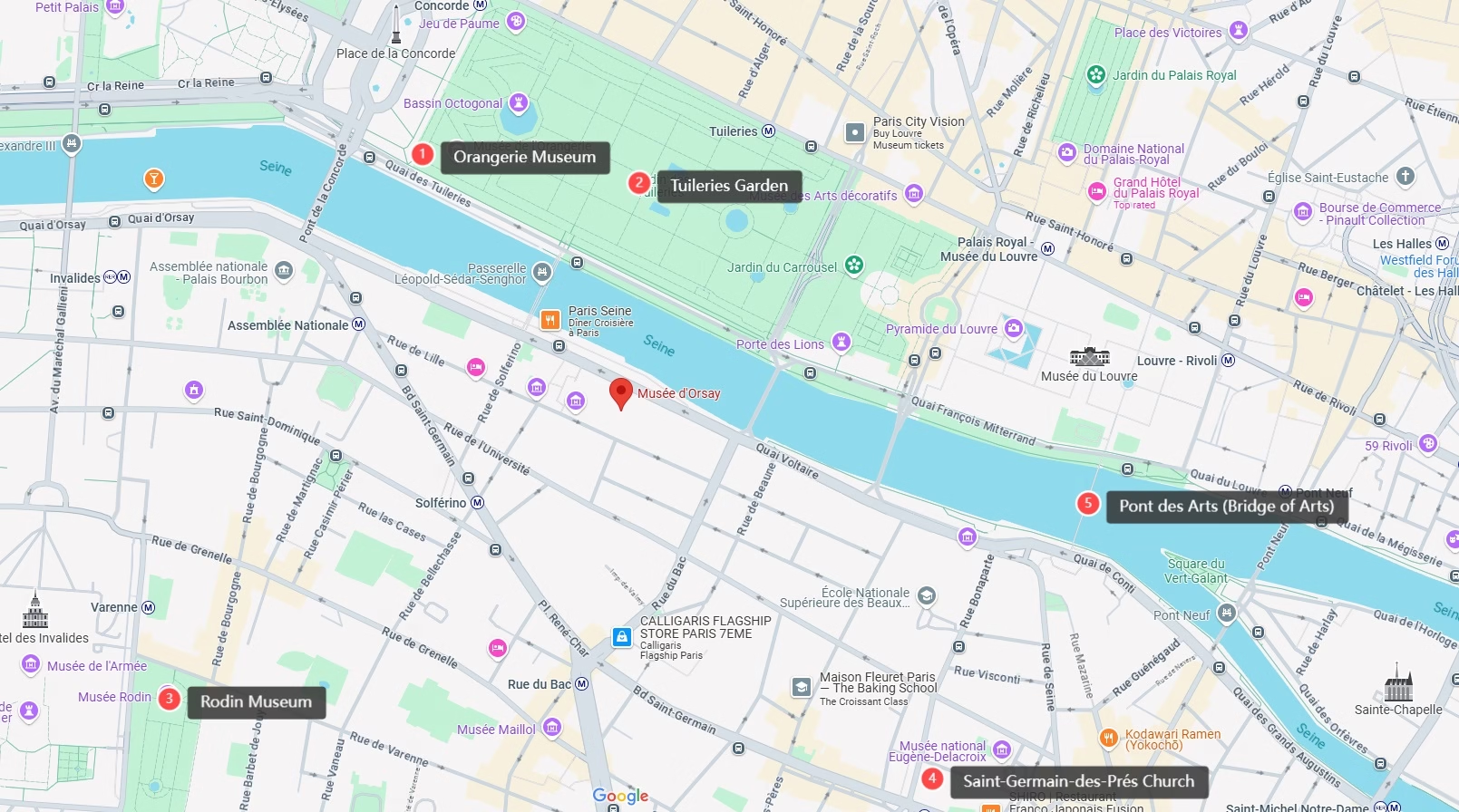
Orangerie Museum

- Distance from Musée d’Orsay: 10-minute walk (800 meters).
- Opening Hours: 9:00 AM – 6:00 PM (Closed on Tuesdays).
- Ticket Price: €12 (Standard ticket).
- Highlights: The Water Lilies by Claude Monet, housed in specially designed oval rooms, are the star of this museum. These immense, panoramic works are among Monet’s most iconic pieces and are not to be missed.
Tuileries Garden

- Distance from Musée d’Orsay: 5-minute walk (400 meters).
- Opening Hours: Open year-round, from 7:00 AM – 9:00 PM (hours vary by season).
- Ticket Price: Free.
- Highlights: This beautiful public garden is a great place to take a break. Stretching between the Louvre Museum and the Place de la Concorde, it is home to fountains, sculptures, and perfectly manicured flower beds.
Rodin Museum (Musée Rodin)

- Distance from Musée d’Orsay: 15-minute walk (1 km).
- Opening Hours: 10:00 AM – 5:45 PM (Closed on Mondays).
- Ticket Price: €13 (Museum ticket).
- Highlights: Home to Auguste Rodin’s masterpieces, this museum is famous for works like The Thinker and The Gates of Hell. The museum’s sculpture garden is a highlight, allowing visitors to view many of Rodin’s iconic pieces outdoors, set among lush greenery.
Saint-Germain-des-Prés Church

- Distance from Musée d’Orsay: 10-minute walk (800 meters).
- Opening Hours: 8:30 AM – 7:30 PM.
- Ticket Price: Free.
- Highlights: Saint-Germain-des-Prés is one of the oldest churches in Paris, dating back to the 6th century. If you’re interested in Parisian history, this is a place to soak in the quiet, historical atmosphere of a church that’s been central to the city’s religious life for centuries.
Pont des Arts (Bridge of Arts)

- Distance from Musée d’Orsay: 5-minute walk (400 meters).
- Opening Hours: Open year-round, 24 hours a day.
- Ticket Price: Free.
- Highlights: It’s a popular spot for taking in stunning views of Paris and the Louvre Museum. The bridge is also known for its history of love locks, where couples would attach a lock with their initials before tossing the key into the Seine (though these locks have been removed in recent years).
Top 5 Affordable Hotels Near Musée d’Orsay

1. Hôtel d’Orsay – Esprit de France
- Distance to Musée d’Orsay: 5-minute walk (350 meters).
- Address: 93 Rue de Lille, 75007 Paris, France.
- Average Cost per Room: €150-220 per night.
- Features: This charming hotel offers a classic Parisian feel with modern touches. The rooms are elegantly decorated, some with views of the Seine River, and the staff is praised for its personalized service.
2. Le Relais Saint-Germain
- Distance to Musée d’Orsay: 12-minute walk (1 km).
- Address: 9 Carrefour de l’Odéon, 75006 Paris, France.
- Average Cost per Room: €180-250 per night.
- Features: A beautiful boutique hotel in the heart of the Saint-Germain-des-Prés district. The rooms are cozy, with some featuring charming views of the streets of Saint-Germain.
3. Hôtel Montalembert
- Distance to Musée d’Orsay: 10-minute walk (800 meters).
- Address: 3 Rue de Montalembert, 75007 Paris, France.
- Average Cost per Room: €190-300 per night.
- Features: This upscale yet affordable hotel offers contemporary design mixed with classic Parisian style. The rooms are spacious by Paris standards, with luxury bedding and elegant décor.
4. Hotel de la Tamise – Esprit de France
- Distance to Musée d’Orsay: 12-minute walk (900 meters).
- Address: 1 Rue d’Alger, 75001 Paris, France.
- Average Cost per Room: €150-230 per night.
- Features: Located near the Tuileries Garden, this charming hotel combines French charm with a contemporary flair. The rooms are decorated with elegant furniture and include modern amenities like free Wi-Fi and air conditioning.
5. Hôtel des Saints-Pères
- Distance to Musée d’Orsay: 10-minute walk (800 meters).
- Address: 65 Rue des Saints-Pères, 75006 Paris, France.
- Average Cost per Room: €160-230 per night.
- Features: A historic hotel with a stylish design that combines contemporary art with classic Parisian elements. The rooms are known for being bright and comfortable, with many offering views of the beautiful Left Bank streets.

